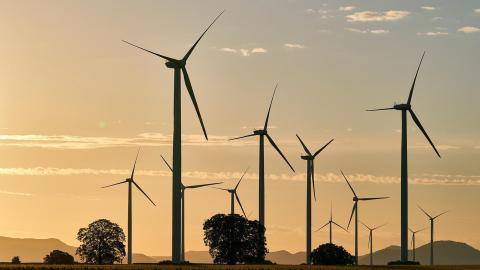IEEFA update: Whether prices are high or low, the oil and gas industry is freighted with risk
Over the past few years, the rationale for investment in fossil fuels has changed from being one supported by blue-chip, long-term value into a more speculative, volatile proposition driven by quarterly dividends.
As a result, the direction of oil prices is increasingly relevant, having become the lens through which investment is assessed, and revenue and profit trends analysed. In the past, cycles of high and low prices were deemed secondary phenomena to the larger story of fossil fuels’ growth in the world economy. But in today’s rapidly changing energy landscape, price is more important, and high- and low-price cycles both present risk.
IEEFA’s recent report, “The Financial Case for Fossil Fuel Divestment,” describes the specific implications of oil price volatility in detail. (See Appendix II of the report).
A long-term change in the global energy landscape is well under way.
Today, the key factor is that in either low-price (less than $70 per barrel) or high-price (greater than $100 per barrel) environments, fundamental technological change is driving the cost and quantity of supply. Declining costs brought on by fracking technology have increased supply and pushed prices down. Advances in renewable energy and electric vehicles have added a dimension of competition. Together, these two changes make the sector’s already complex and crowded cumulative risk profile increasingly unmanageable.
Market volatility and the various other issues swarming around oil prices and politics often make the industry’s storyline difficult to follow. But blow away the smoke from trade wars, commodity trends, short sellers and internecine fights within OPEC, and a much clearer framework emerges: whether prices are up or down.
A LOW-PRICE ENVIRONMENT LIKE THE ONE THAT PERSISTED FOR MUCH OF THE PAST SEVERAL YEARS can lead to significant losses in revenue; decreases in stock value; increases in bankruptcies, defaults and write-offs of reserves; and a general weakening of public and investor confidence.
The recent prolonged low-price environment caused many oil and gas companies to adopt aggressive cost-cutting practices and to curtail capital spending. The industry now sees its long-term outlook as clouded both by low prices and the likely necessity of having to alter its business models, political alliances and investment patterns to help it manage climate risk, which continues to undermine the industry.
Costs have become a crucial determinant of financial success. Still, company efforts at cost discipline have not improved the sector’s outlook, which remains challenged by the size, pace and duration of declines since a core price collapse in 2014.
Low prices put pressure on profitability margins, making capital access more difficult, and increasing bankruptcies and write-offs. A low-price, volatile environment makes it more difficult to continue justifying capital expenditures for drilling, pipelines, mining and other infrastructure, especially as companies are still writing off prior failures.
A low-price environment for oil and gas also presents challenges to market share for both commodities. In the U.S., low natural gas prices persist due to technological advances introduced by fracking and the supply of cheap gas that has developed. Low natural gas prices have driven coal’s market share from 50% of the electricity market to 30% over the past decade. This trend has been accelerated by the growth of renewable energy.
The new cycle of technological innovation sweeping the energy sector has pushed down the cost of energy and created a competitive threat to historically monopolistic fossil fuels. The risk is material, and the financial rationale for the sector is weak.
YET RISK IS HIGH ACROSS THE SECTOR IN A HIGH-PRICE ENVIRONMENT AS WELL, regardless of the fact that in the past, the industry has been able to count on long periods of rising prices to reward investors and finance capital expenditures.
As prices have recently returned to higher levels, competition between oil and gas producers, increased competition from other forms of energy, geological challenges and other political and economic factors indicate that spikes will be lower and of shorter duration than they have been in the past. Even in an upmarket, this spells serious trouble.
As oil prices have moved lately from the high $60-per-barrel range to more than $70, consumption nations like India and Japan are raising red flags. Leaders of producer nations have also expressed concern. These warnings are occurring at price levels that are not conducive to industry-wide recovery, as the volatility and the events driving it only deepen a climate of instability.
Oil companies, once gung-ho in a rising price environment to take on greater levels of risk and higher-cost reserves, are now tiptoeing into the renewable energy sector. Some are also looking at petrochemicals as a growth area.
The challenge to maintain investor confidence is enormous in the face of skepticism that new investments will produce high returns.
THE WAVE OF TECHNOLOGICAL CHANGE NOW DRIVING the growth of renewable energy and electric vehicles means fossil fuels are expensive at any price. Renewable energy has zero fuel costs, is anti-inflationary and is less volatile. From the market’s point of view, coal loses to natural gas on price, and natural gas is now pressured by renewable energy. Zero cost will always beat cheap!
Have these technologies and markets advanced enough to create a cap on the size and duration of oil price spikes?
Rising prices once led to a variety of defensive economic adjustments by consumers and governments, including lower consumption; lower fuel taxes and government reliance on short-term fiscal fixes.
Today, a new dynamic is at play: renewable energy and electric vehicles are diluting the fossil fuel monopoly. Because lower-price energy alternatives are available, high energy prices will most likely curtail demand for fossil fuels and accelerate the shift toward renewables, probably for the long term.
Tom Sanzillo is IEEFA’s director of finance, Kathy Hipple is an IEEFA financial analyst, and Clark Williams-Derry is a contributing researcher.
RELATED ITEMS:
IEEFA Update: New Oil Price Volatility Will Help Drive Transition From Fossil Fuels
IEEFA op-ed: Colorado’s pension fund shouldn’t bank on the future of oil and gas

















